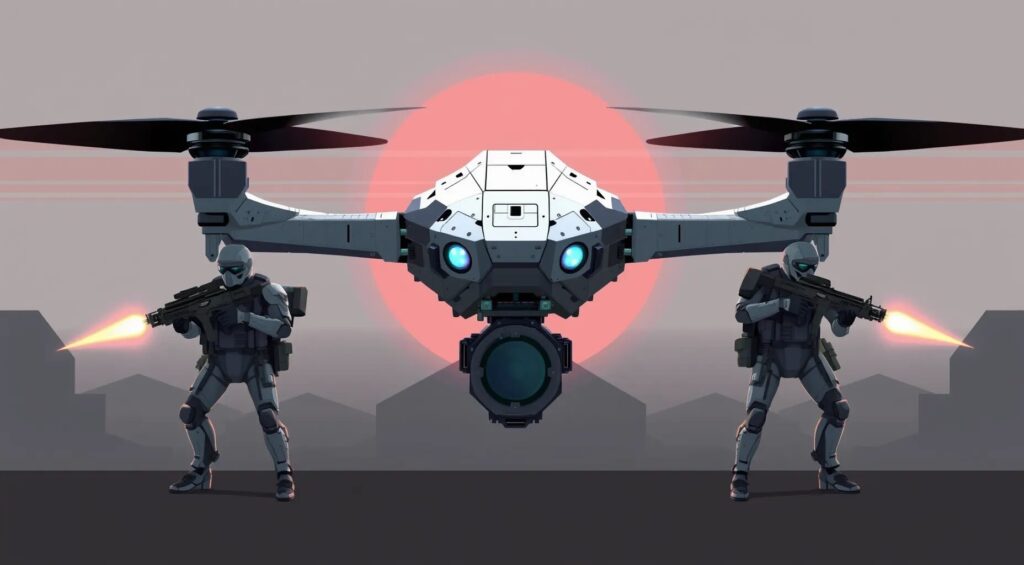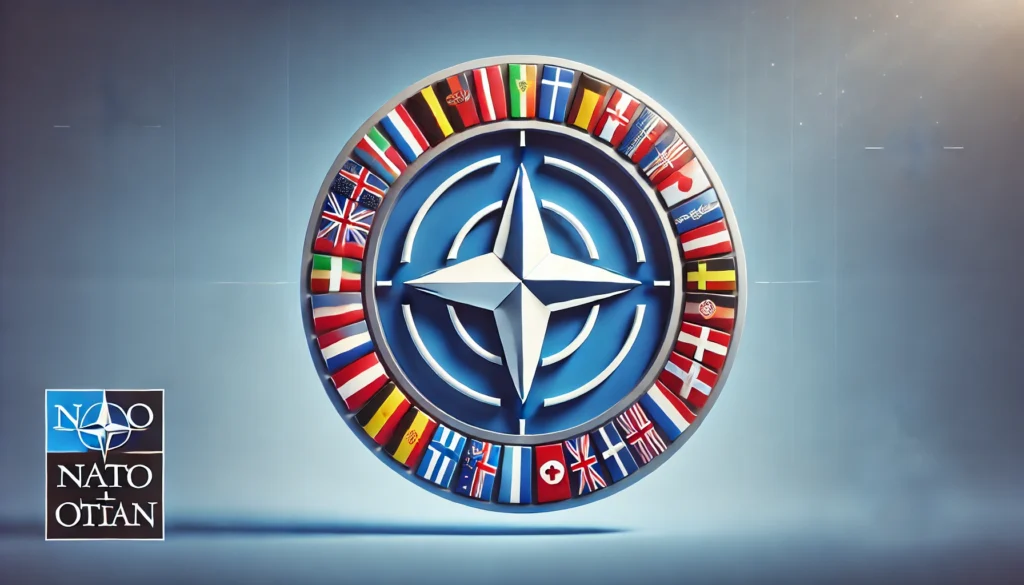
The global landscape is changing, and with it, the nature of warfare. Nations no longer just stockpile missiles or race to build nuclear arsenals—they’re also pouring resources into artificial intelligence (AI)-driven military technology. This new era of competition is about who can develop the smartest weapons, the most advanced drones, and the most autonomous systems. But, as with any arms race, this rush to develop AI-powered weapons comes with significant geopolitical consequences.
The Front-Runners in the AI Military Race
In the quest for AI supremacy, a few nations are pulling ahead, each with its unique strategies and goals. The United States and China are the two main contenders, but other countries like Russia, Israel, and even some European nations are making significant strides.
The United States: A Legacy of Innovation
The U.S. has long been a leader in military technology, and it’s no different when it comes to AI. The Department of Defense (DoD) has invested billions in AI research, focusing on developing autonomous systems, cybersecurity, and advanced weaponry. The Pentagon’s Joint Artificial Intelligence Center (JAIC) is at the forefront of these efforts, working to integrate AI into everything from logistics to combat operations.
But the U.S. isn’t just focused on military applications. There’s a push to ensure AI is used ethically, reflecting democratic values. However, this ethical stance might slow down progress, especially when compared to nations that prioritize speed over ethical concerns.
China: The Rising Superpower
China is the most formidable rival to the U.S. in the AI arms race. The Chinese government has made AI a national priority, with ambitious plans to become the world leader in AI by 2030. Their approach is different from the U.S.—they have fewer ethical constraints and a centralized government that can mobilize resources quickly and efficiently.
China’s AI development isn’t just limited to defense. They’re integrating AI across various sectors, giving them a broad base of knowledge and technology to draw from. Chinese companies like Huawei and Baidu are also key players, blurring the lines between private industry and military application.
Russia: The Dark Horse
Russia, too, is making significant investments in AI, although it lags behind the U.S. and China. Russian efforts focus on cyber warfare, autonomous vehicles, and robotic systems. Unlike the U.S. and China, Russia tends to keep its developments more secretive, making it harder to gauge their true capabilities.
However, Russia’s strength lies in its willingness to use AI in unconventional and asymmetric ways. Cyber-attacks and AI-driven disinformation campaigns are areas where Russia excels, posing a different kind of threat in this new arms race.
The Role of Smaller Nations
While the U.S., China, and Russia dominate headlines, smaller nations are also key players. Israel is renowned for its advancements in drone technology, and its military is heavily investing in AI to maintain its edge. European countries, while generally more cautious, are collaborating on AI defense projects within NATO, ensuring they don’t fall too far behind.
Regional Tensions and AI Weapons: Flashpoints in Asia, Europe, and the Middle East

Asia: The South China Sea—A High-Tech Powder Keg
The South China Sea has long been a flashpoint in Asia, with multiple countries—most notably China, Vietnam, the Philippines, Malaysia, and Brunei—claiming overlapping territories. The strategic importance of this region, rich in natural resources and crucial for global shipping, makes it a hotbed for geopolitical rivalry. AI-driven military technology is now adding a new layer of tension.
China’s AI-Enhanced Military Presence
China has been assertive in its territorial claims, building artificial islands and militarizing them with advanced weapons systems. The use of AI in surveillance, autonomous drones, and AI-driven naval vessels has amplified China’s ability to monitor and control vast areas of the South China Sea. These AI-enhanced capabilities allow China to maintain a constant, real-time presence, effectively enforcing its claims with minimal human intervention.
China’s deployment of autonomous surveillance systems—capable of tracking and identifying vessels without direct human control—has increased the risk of accidental or intentional confrontations. These AI systems can make split-second decisions that might escalate into larger conflicts, especially if they misinterpret the actions of other nations’ vessels.
The Regional Response
In response, neighboring countries and external powers like the United States have begun developing and deploying their own AI-driven technologies. The U.S., in particular, has increased its presence in the region, using AI to enhance its intelligence-gathering and surveillance capabilities. These efforts are aimed at countering China’s dominance, but they also contribute to a technology-fueled arms race in the region.
The introduction of AI into this already tense environment could lead to miscalculations and unintended escalations, as automated systems might react aggressively to perceived threats. The lack of established protocols for AI-driven military engagement in such close quarters only heightens the risk.
Europe: Eastern Europe and the AI-Driven Proxy Wars
Eastern Europe is another region where AI-driven military technology is influencing tensions, particularly in the ongoing conflict between Russia and Ukraine, and the broader standoff between Russia and NATO. The annexation of Crimea by Russia in 2014 and the subsequent conflict in Eastern Ukraine have created a long-standing and volatile situation. Here, AI is being used to enhance both conventional and hybrid warfare.
Russia’s AI-Driven Military Strategy
Russia has been leveraging AI to support its military operations, particularly in the realms of cyber warfare, electronic warfare, and autonomous weapon systems. The use of AI to conduct cyber-attacks on critical infrastructure in Ukraine and other NATO-aligned states has become a hallmark of Russia’s strategy. These AI-driven cyber tools can disrupt communications, target infrastructure, and spread disinformation, all while remaining difficult to trace directly to the Russian government.
Moreover, Russia’s development of autonomous ground and aerial systems has enabled it to conduct operations with a reduced risk to personnel. For example, AI-controlled drones have been used for reconnaissance and even targeted strikes, complicating the battlefield for Ukraine’s forces and their NATO supporters.
NATO’s Response and the Risk of Escalation
In response, NATO has increased its focus on AI in defense, with member states investing in AI-driven intelligence, surveillance, and reconnaissance (ISR) systems. NATO’s strategy emphasizes the integration of AI into multi-domain operations, ensuring that land, sea, air, and cyber forces can operate cohesively with AI support.
However, the proliferation of AI-driven military tools in Eastern Europe increases the risk of misinterpretation and rapid escalation. Autonomous systems, particularly those involved in cyber warfare, can initiate responses without direct human oversight, potentially leading to unintended conflicts between Russia and NATO forces. The fog of war, exacerbated by AI, could make it harder to de-escalate situations before they spiral out of control.
The Middle East: AI and the New Face of Proxy Wars
The Middle East has been a region of persistent conflict, with powers both within and outside the region vying for influence. In recent years, AI-driven military technology has become a significant factor in these conflicts, particularly in the ongoing proxy wars in countries like Syria and Yemen.
AI in the Hands of Regional Powers
Countries like Israel, Iran, and Saudi Arabia are increasingly incorporating AI into their military strategies. Israel, for instance, has been a pioneer in drone warfare and AI-driven defense systems like the Iron Dome, which uses AI to intercept incoming rockets with remarkable precision. Israel’s use of AI in intelligence and surveillance has given it a significant edge in maintaining security against threats from both state and non-state actors.
On the other hand, Iran has been investing in AI-driven cyber warfare capabilities and autonomous systems, which it uses to bolster its influence in proxy conflicts. Iran’s ability to deploy AI-enhanced drones and cyber tools in theaters like Syria and Yemen has allowed it to project power more effectively, often challenging U.S. and Israeli interests in the region.
The Proxy War Dynamics
In the complex and fragmented conflicts of the Middle East, AI is being used to enhance the effectiveness of proxy forces. Autonomous drones and AI-driven surveillance systems allow regional powers to support their proxies with greater precision and less risk of direct involvement. However, this also means that conflicts can be prolonged and intensified, as AI reduces the cost and risk of sustained engagement.

Geopolitical Consequences: A New Kind of Cold War?
As AI-driven military technology advances, the geopolitical landscape is becoming more complex and unpredictable. The race for AI superiority could lead to a new kind of Cold War, with nations engaging in an arms race not just in physical weaponry but in algorithms and autonomous systems.
Increased Tensions and Mistrust
One of the most immediate consequences of this AI arms race is increased global tension. Nations are wary of each other’s advancements, leading to an atmosphere of mistrust. This is particularly evident between the U.S. and China, where suspicions of espionage and cyber-attacks are rampant.
This mistrust extends to the international community as well. As nations develop AI technologies in secret, it becomes harder to maintain global security. Traditional arms control agreements are ill-equipped to handle the complexities of AI, leading to calls for new treaties and international regulations.
Ethical Dilemmas and the Risk of Autonomous Warfare
Another significant consequence is the ethical dilemma posed by AI-driven weapons. Autonomous systems that can make life-or-death decisions without human intervention raise serious moral and legal questions. The potential for autonomous warfare, where machines fight without human oversight, is not just a distant sci-fi scenario—it’s a looming reality.
Nations are grappling with these issues, but there is no global consensus on how to regulate AI in the military. Without international cooperation, there’s a risk that the most aggressive and least ethical uses of AI will dominate the battlefield.
The Shift in Power Dynamics
AI has the potential to shift global power dynamics in unexpected ways. Traditionally, military might was tied to economic power and the size of a nation’s armed forces. But with AI, even smaller nations or non-state actors could wield significant power, using technology to level the playing field.
The Cold War Redux: AI and Nuclear Parallels
The Cold War was marked by an intense rivalry between the United States and the Soviet Union, with both sides amassing vast nuclear arsenals in a bid to deter each other through the doctrine of Mutually Assured Destruction (MAD). While today’s AI arms race is different in many ways, there are striking parallels that suggest we may be on the brink of a new kind of Cold War.
The Technology Race
Just as the Cold War era saw a race to build more powerful nuclear weapons, today’s competition centers on developing the most advanced AI technologies. Nations are not just focused on building AI for civilian use; they are prioritizing AI for military applications. This includes autonomous drones, AI-driven missile defense systems, and sophisticated cyber warfare tools.
The speed at which AI technology is evolving has created a sense of urgency. Nations fear that falling behind in the AI race could leave them vulnerable to attacks or diminish their influence on the global stage. This mirrors the Cold War mentality, where the fear of a nuclear first strike or a technological gap drove relentless innovation and escalation.
Secrecy and Mistrust
During the Cold War, secrecy and mistrust fueled the arms race. Nations kept their nuclear capabilities under wraps, and espionage was rampant. In the AI arms race, similar dynamics are at play. Countries are developing AI technologies in secret, with limited transparency. This lack of openness breeds suspicion and heightens the risk of misunderstandings, much like during the Cold War.
Moreover, the AI arms race is not just about physical weapons. Cyber warfare and AI-driven disinformation campaigns are increasingly important tools in this new era of conflict. These tools are harder to detect and can be used covertly, making it difficult for nations to trust each other’s intentions.
The Challenge of AI Arms Control
During the Cold War, the world eventually recognized the need for arms control agreements to prevent catastrophe. Treaties like the Strategic Arms Limitation Talks (SALT) and the Intermediate-Range Nuclear Forces (INF) Treaty were established to reduce the risk of nuclear war. But when it comes to AI, the path to arms control is far less clear.
The Complexity of AI
One of the main challenges in developing AI arms control agreements is the complexity and versatility of AI itself. Unlike nuclear weapons, which are relatively straightforward to define and regulate, AI encompasses a broad range of technologies with applications across many sectors. Regulating AI in the military would require not only defining what constitutes an AI weapon but also determining how to monitor and enforce restrictions.
The dual-use nature of AI—its ability to serve both civilian and military purposes—complicates matters further. AI technologies developed for civilian industries can easily be adapted for military use, making it difficult to draw clear lines between permissible and impermissible applications.
Lack of International Consensus
Another significant obstacle is the lack of international consensus on AI arms control. While some nations recognize the need for regulation, others are reluctant to impose limits that could stifle innovation or weaken their strategic position. The United States and China, in particular, have differing views on the role of AI in the military and the necessity of arms control. This divide makes it challenging to reach a global agreement.
Furthermore, existing international frameworks are ill-equipped to address the unique challenges posed by AI. The United Nations and other international bodies have begun discussing the issue, but progress has been slow. There is no clear roadmap for how to regulate AI in a way that balances security concerns with the need for innovation.
The Risk of Escalation
Without effective AI arms control, the risk of escalation looms large. Just as the Cold War’s nuclear arms race led to a precarious balance of power, the AI arms race could create a volatile global environment. The deployment of autonomous weapons and AI-driven defense systems could lead to unintended conflicts, especially if AI systems make decisions without human oversight.
The potential for cyber warfare to disrupt critical infrastructure adds another layer of risk. Unlike nuclear weapons, which were primarily deterrents, AI weapons can be used covertly and on a much wider scale. A cyber-attack on a nation’s power grid or financial system could have devastating consequences without a single missile being fired.
Conclusion: The Need for Caution and Cooperation
The AI arms race is accelerating, with the U.S., China, and Russia leading the charge. But this race is not without its dangers. The potential for increased global tension, ethical dilemmas, and a shift in power dynamics makes this a critical issue that the world cannot afford to ignore.
International cooperation and regulation are essential to prevent this race from spiraling out of control. Nations must come together to establish guidelines for the development and use of AI in military applications, ensuring that this powerful technology is used responsibly and ethically.
In the end, the global AI arms race is not just about who has the smartest weapons, but about how the world can navigate this new frontier without losing its humanity.
Websites
- Center for a New American Security (CNAS)
- A think tank that publishes extensive research on national security and AI, including reports and articles on AI-driven military technology.
- The Bulletin of the Atomic Scientists
- Offers articles and resources related to AI and global security, including discussions on autonomous weapons and arms control.
- The International Institute for Strategic Studies (IISS)
- Provides analysis and reports on global military developments, including the impact of AI on regional conflicts.





